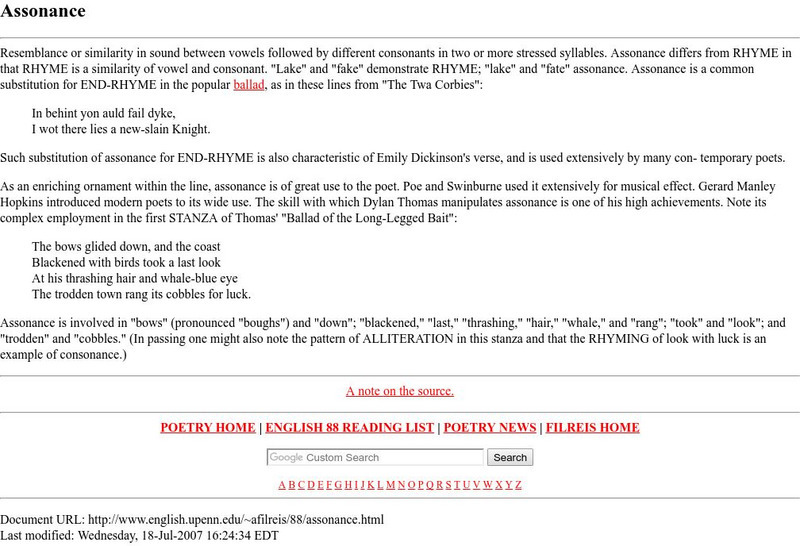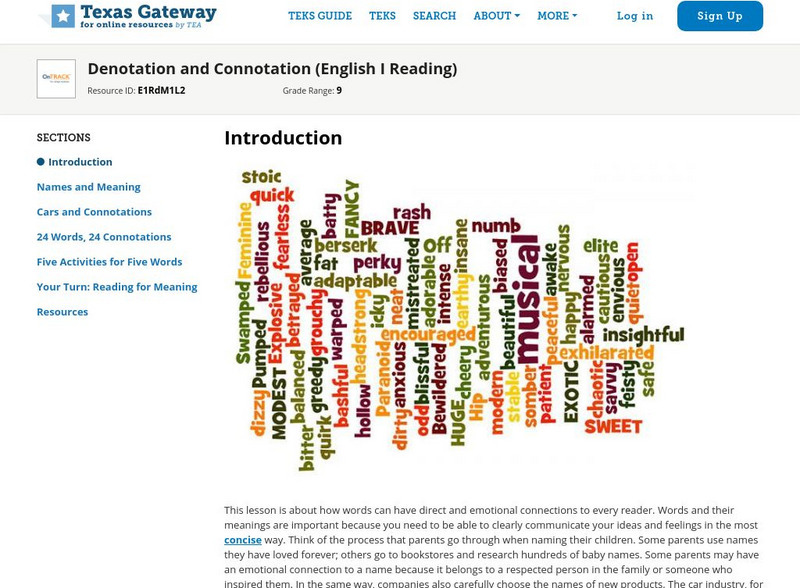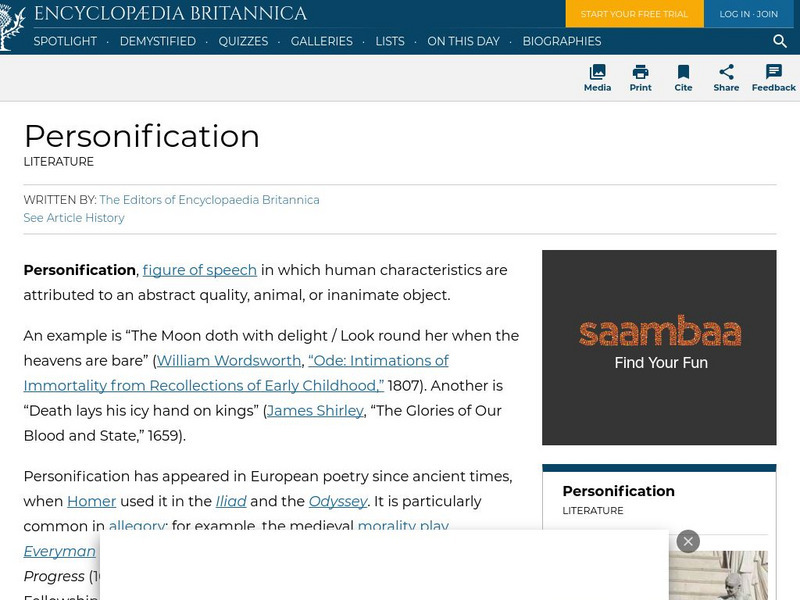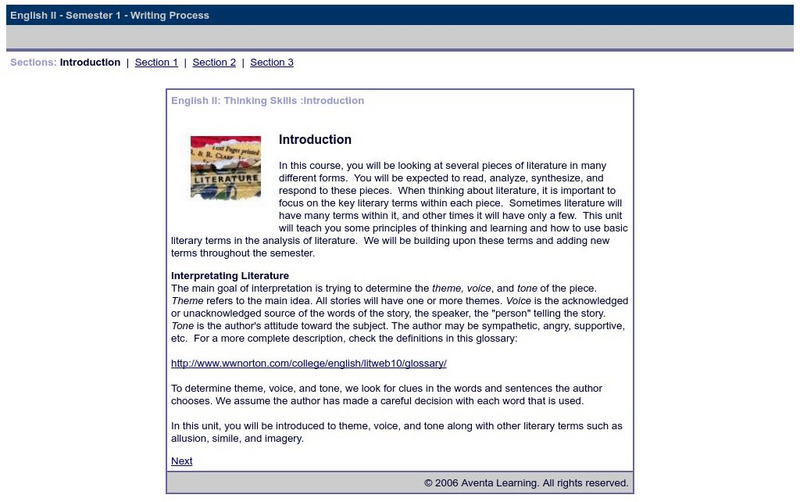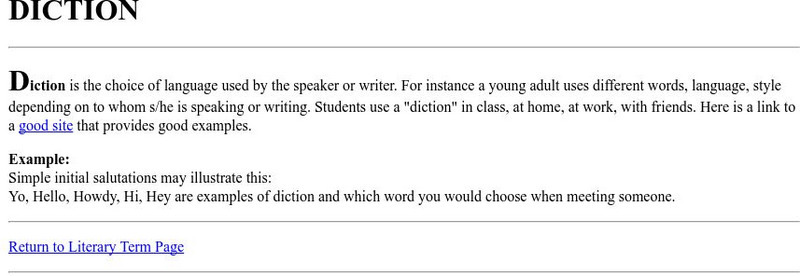University of Pennsylvania
University of Pennsylvania: Assonance
This resource provides a detailed explanation of the term "assonance." Several examples provided as well as links to related sites.
PBS
Wnet: Thirteen: I Have a Metaphor
This lesson not only examines the message of Dr. King, but also the words themselves. This is a lesson in identifying the literary devices that he used in his "I Have a Dream" Speech. It will introduce the following literary devices:...
Texas Education Agency
Texas Gateway: Compare/contrast Themes and Genres in Literary Texts
You will learn how to analyze, make inferences, and draw conclusions about theme and genre in different cultural, historical, and contemporary contexts and provide evidence from the text to support your understanding.
Texas Education Agency
Texas Gateway: Allusions to Mythological, Classical, and Traditional Texts
You will be able to identify and understand allusions in myths, the classics, and other traditional texts and their influence on modern literature.
Texas Education Agency
Texas Gateway: Denotation and Connotation (English I Reading)
Distinguish between the denotative (dictionary) meaning of a word and its connotative (emotions or associations that are implied rather than literal) meaning. L.9-10.5b nuances
Texas Education Agency
Texas Gateway: Importance of Figurative Language: Practice 3 (English I Reading)
Read a text and understand how the figurative language of a literary work contributes to its historical and cultural setting.
Texas Education Agency
Texas Gateway: Close Reading of Poetry: Practice 2 (English I Reading)
Read carefully in order to identify allusion, imagery, metaphor, and symbolism and to evaluate their impact on the meaning of a text. RL.9-10.9 alllusions to other works.
Texas Education Agency
Texas Gateway: Denotation and Connotation (English I Reading)
This lesson focuses on denotation and connotation including the abilty to distinguish words according to their emotional or cultural meaning. Your ability to do so can help you understand the author's purpose or more about a character in...
CommonLit
Common Lit: Egg
CommonLit.org is a wonderful resource to use in a Language Arts classroom. Each story, article or poem is accompanied by guided reading questions, assessment questions, and discussion questions. In addition, students can click on words...
Love To Know Media
Your Dictionary: Literary Terms Lesson Plan
This is a lesson plan for teaching the seven literary terms used in poetry: simile, metaphor, alliteration, imagery, hyperbole, personification, and onomatopoeia.
Love To Know Media
Your Dictionary: Literary Terms to Know in Seventh Grade
This site lists and briefly defines the literary terms 7th graders should know including types of writing, literary devices, sound devices, figurative language, and parts of a story,
Encyclopedia Britannica
Encyclopedia Britannica: Literature: Personification
Explains what personification is and gives examples. Includes links to related articles on symbolism, elements of rhetoric, fables, figure of speech, and allegory.
Department of Defense
Do Dea: Thinking Skills
In this self-guided course, you will be looking at several pieces of literature in many different forms. This unit will teach you some principles of thinking and learning and how to use basic literary terms in the analysis of literature....
Other
University of North Carolina: Glossary of Literary Terms
This site is provided for by the University of North Carolina at Pembroke. Over forty literary terms defined by college students, each with thorough examples.
Quizlet
Quizlet: Literary Elements/humorous Fiction Terms Flashcards
Literary elements are included in this review exercise. Flashcards are provided for the following words: allusion, antagonist, dialogue, flashback, imagery, protagonist, symbol, dialect, hyperbole, idiom, irony, parody, pun, sarcasm,...
Ted Nellen
Cyber English (By Ted Nellen): Literary Terms
This is an extensive glossary of literary terms.
PBS
Pbs Learning Media: Literary Elements and Techniques: Tone and Mood
Explore the difference between tone and mood in this animated video [2:28] from WNET through definitions and examples from poetry and prose. Discussion questions below help students to further apply their understanding before analyzing a...
PBS
Pbs Learning Media: Literary Elements and Techniques: Imagery
Explore the literary technique of imagery to see how sensory language contributes to the meaning and feeling of a poem in this animated video [1:23] from WNET. Discussion questions below help students to further apply their understanding...
PBS
Pbs Learning Media: Literary Elements and Techniques: Symbolism
Explore how authors use symbolism to add a deeper level of meaning to their work in this short animated video [1:12] from WNET. Discussion questions below help students to further apply their understanding before analyzing a text.
Ted Nellen
Cyber English (By Ted Nellen): Consonance
This is a glossary entry for the term "Consonance" including the defintion and an example.
Ted Nellen
Cyber English (By Ted Nellen): Literary Term: Onomatopoeia
For a clear explanation of onomoatopoeia and several examples from well-known poets, use this page.
Ted Nellen
Cyber English (By Ted Nellen): Connotation
This is a glossary entry for the term "Connotation" including the definition and an example.
Ted Nellen
Cyber English (By Ted Nellen): Diction
This is a glossary entry for the term "Diction" including a definition, an example, and a link to more examples.
Ted Nellen
Cyber English (By Ted Nellen): Symbol
This is a glossary entry for the term "Symbol" including definitions and examples.


